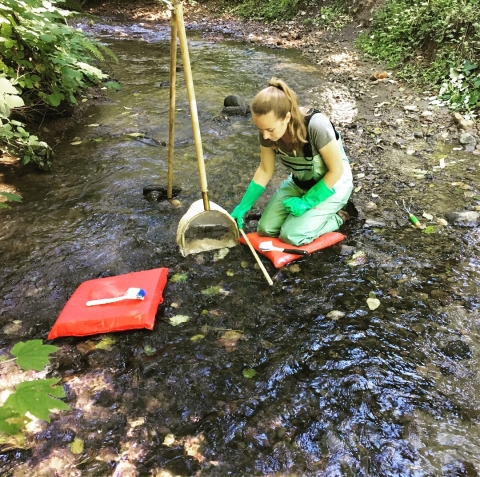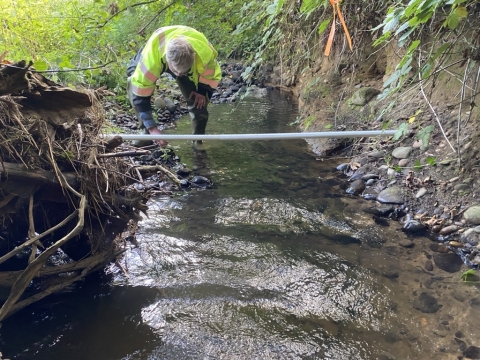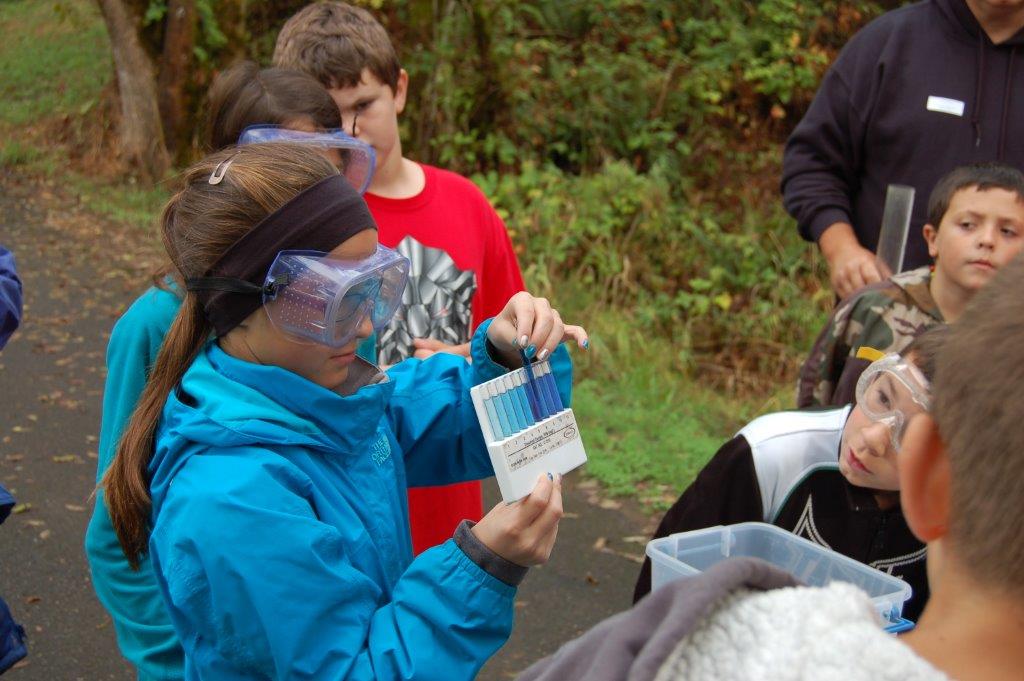Stream Health and Monitoring
Water quality, hydrology and stream health monitoring provides data that inform and prioritize Clean Water’s efforts to protect county waterways. Monitoring allows the county to better understand the health of individual waterways or entire watersheds and follow over time if conditions are improving, deteriorating or not changing.
Clean Water staff use monitoring information to design projects to improve stream health, coordinate watershed planning with other agencies and partners, and develop education, outreach and stewardship resources to support our community protecting water. Hydrology data is used to support development projects and measure changes in water quantity for regional planning. Monitoring is also required under the county’s NPDES Phase I Municipal Stormwater Permit.
Clean Water staff collecting a benthic macroinvertebrate sample.
Stream Health Report
The Clean Water Division maintains a Stream Health Report to share monitoring data with the community. The report includes interactive maps and data tables that display stream health trends, current and past statuses for various streams by water quality parameter, hydrology data and more. The Stream Health Report is part of the larger Explore Your Watershed StoryMap that covers Clark county’s watersheds, recreation opportunities and things people can do to protect water. View previous stream health reports below.
Stream Health Status and Trends Section
Clark County monitors the current status of stream health at more than 40 sites and long-term trends at nine sites. The monitoring program assesses overall stream health based on water quality, biological health and stream flow conditions. View this data on the county’s Stream Health Report.
Lower Columbia Urban Streams Monitoring Section
This monitoring project is designed to assess the current stream conditions and eventually answer the question: Are the quality and biota conditions of receiving waters in the region improving with broad implementation of required stormwater management practices? The Lower Columbia urban streams study collects water and sediment chemistry, in-stream and riparian habitat information, and benthic macroinvertebrate samples. Streamflow and temperature are continuously monitored at each site. Learn more about the project and see the data collected at Ecology’s Lower Columbia urban streams page. See full plan below.
Stream Flow and Precipitation Monitoring Section
An important factor in stream health is the volume of water and how fast it moves through a stream, creek or river. Increased volumes and faster flows lead to erosion and loss of habitat within the stream channel and on the banks. The Clean Water Division monitors stream flow at seven locations and precipitation at six locations within the county. Hydrology data are used to support development projects, modeling efforts, and measuring changes in water quantity in support of regional water planning efforts. See hydrology data on the county’s Stream Health Report.
Microbial Source Tracking (MST) Section
Elevated levels of bacteria can impair stream water quality. Microbial source tracking (MST), also referred to as bacterial or fecal source tracking, is a set of techniques used to determine the sources of fecal bacteria in the environment. MST techniques attempt to determine sources of fecal bacteria introduced into water bodies by humans, wildlife, or domestic animal sources. MST is used to support the county’s pollution identification and correction (PIC) efforts, where sources causing water quality issues can be pinpointed and corrected through outreach, technical assistance and other methods. PIC programs such as Poop Smart Clark have used MST in Whipple Creek and the East Fork Lewis River, see reports below.
Illicit Discharge Detection and Elimination (IDDE) Section
Illicit discharges are broadly defined as polluted, non-stormwater discharges entering the storm sewer system. Examples include improper cross-connections where sanitary sewer pipes are connected to storm sewer pipes, leaking sewer lines or septic systems, and illegal dumping of materials that reach storm drains such as wash water, waste oil or paint. Illicit discharges contribute pollutants to stormwater and may cause exceedances of pollutant thresholds in receiving waters during baseflow conditions. The overall goal of the IDDE Screening project is to detect, isolate, and eliminate illicit discharges to Clark County’s storm sewer system.
Heritage Farm Wetland Monitoring Section
As part of the larger Heritage Farm Wetland Restoration project, a 1500-foot channelized section of the Cougar Creek headwaters will be monitored before and after restoration to evaluate changes in wetland habitat, stream flows, and water quality. This restoration project provides an ideal opportunity to showcase the benefits of reversing historical ditching through the construction of a series of stepped wetland cells. The goals of the Heritage Farm Wetland Restoration project are to enhance and restore the Cougar Creek headwater wetland habitat, improve stream water quality and groundwater recharge, and reduce peak stormflows and downstream erosion from hard surface runoff.
Other Types of Monitoring Efforts
Monitoring activities are conducted throughout Clark County’s watersheds, including in:
Publications and Reports
The Clean Water Division’s Monitoring and Assessment reports follow standard operating procedures (SOPs) and quality assurance project plans (QAPP) and are available to the public with the goal of providing quality scientific information on our various projects.



